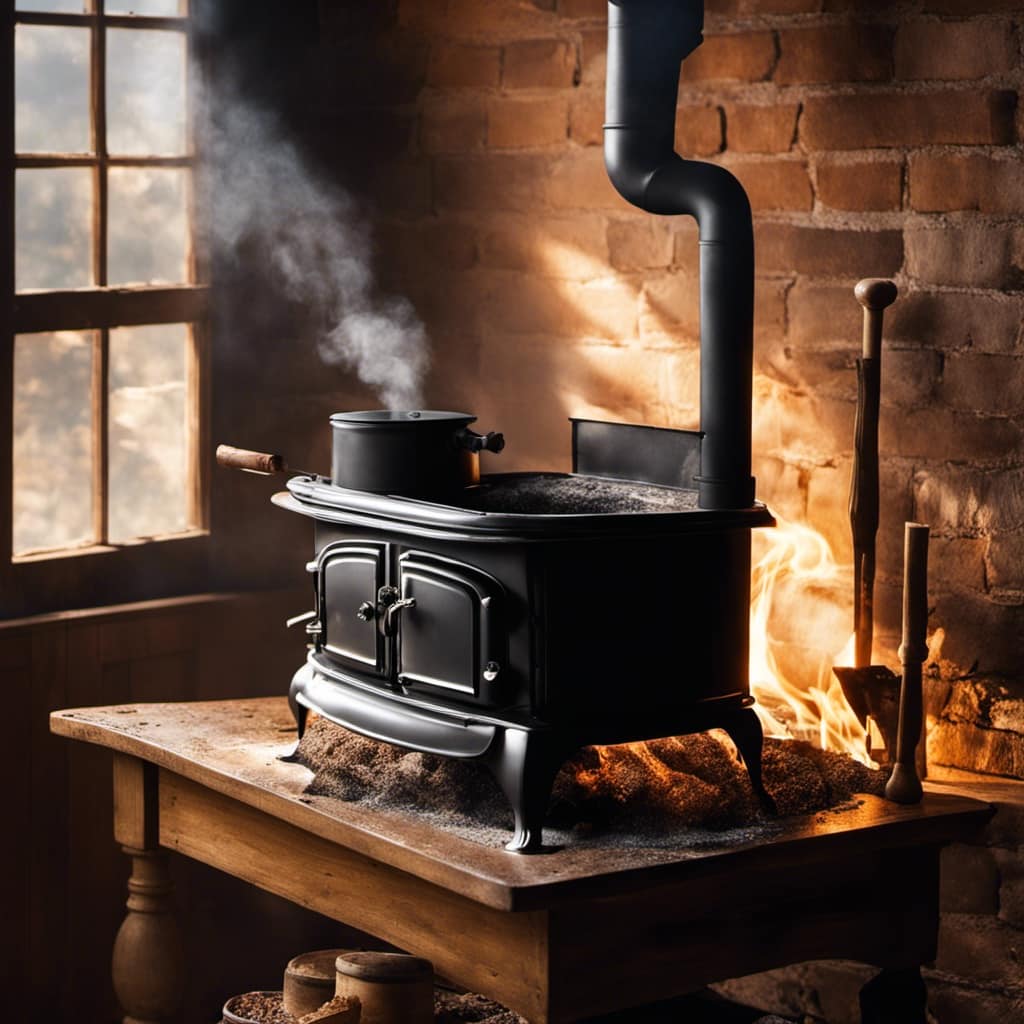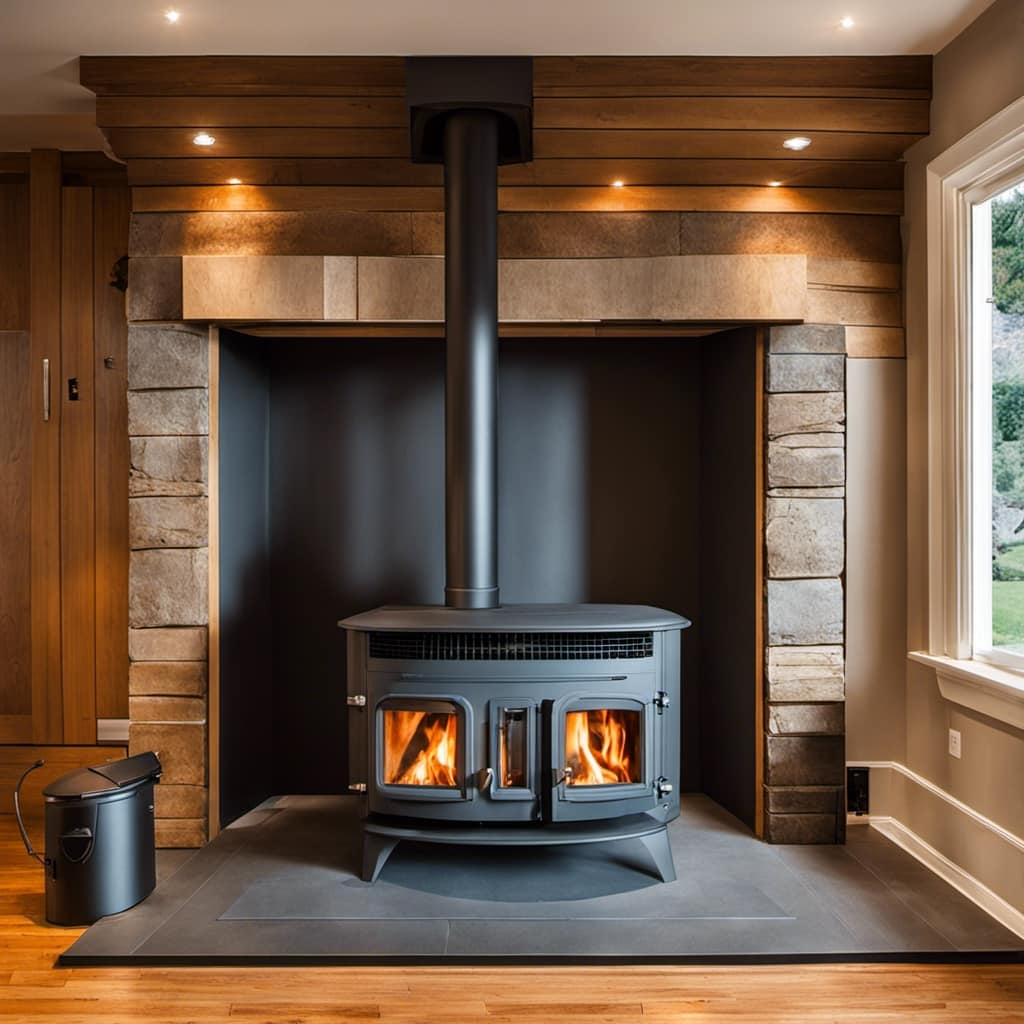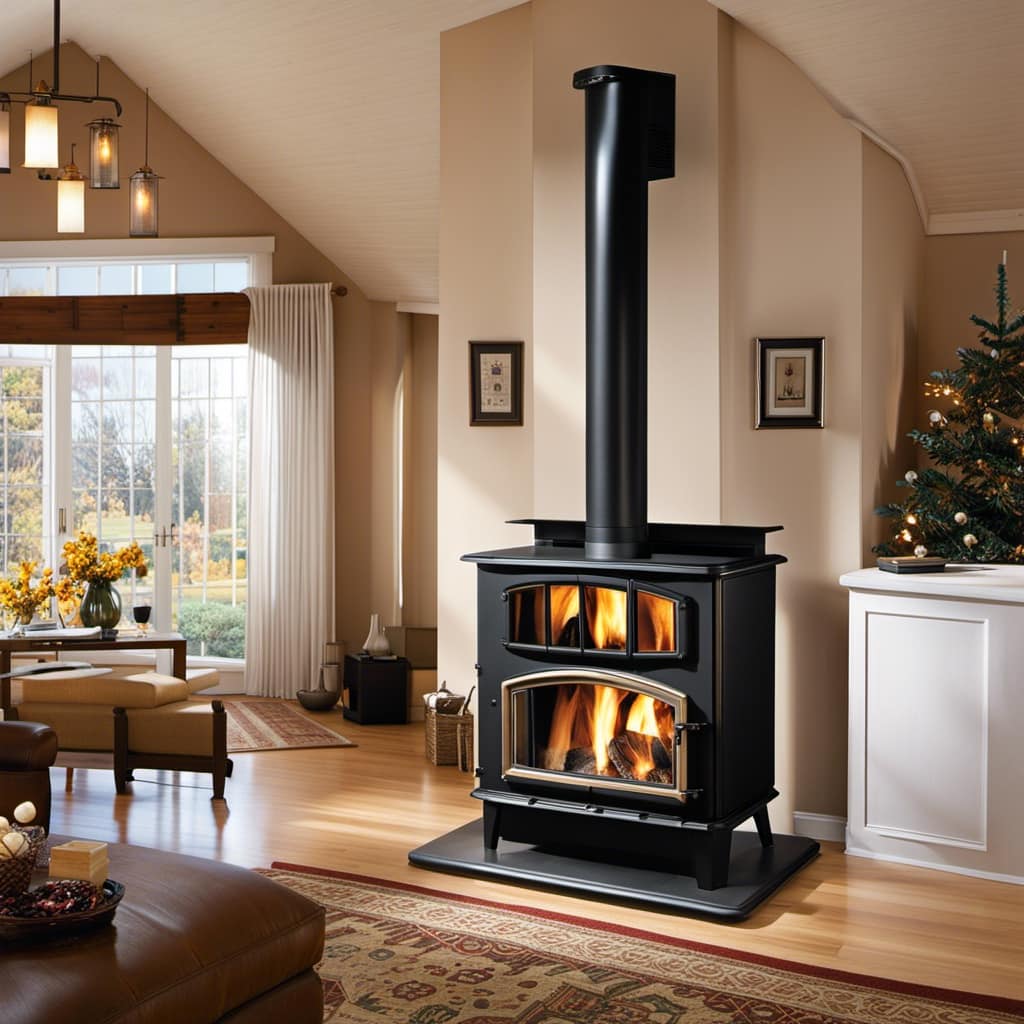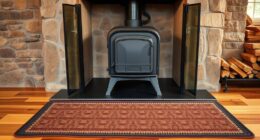
Being someone who is passionate about wood stoves, I have always been fascinated by the detailed components that enable these heating devices to function effectively.
One such component that plays a crucial role is the baffle. Think of it as the conductor of your wood stove orchestra, directing the flow of heat and gases for maximum efficiency.
In this article, we’ll delve into the world of baffles, exploring their function, types, and how they improve the performance of your wood stove.
So, let’s unravel the mystery of the baffle together!

Key Takeaways
- Baffles in a wood stove direct the flow of air and gases, ensuring proper insulation and heat retention.
- Different types of baffles, such as secondary combustion, catalytic, and heat exchange baffles, enhance wood stove performance.
- Baffles improve efficiency by increasing heat transfer, preventing smoke and gases from escaping too quickly, and minimizing creosote buildup.
- Regular cleaning, maintenance, and proper wood selection are essential for optimal baffle performance and longevity.
The Function of a Baffle in a Wood Stove
I can explain how the baffle in my wood stove improves combustion efficiency.
The baffle plays a crucial role in directing the flow of air and gases within the stove.
It’s important to ensure that the baffle is properly insulated to maximize heat retention and prevent heat loss.
Proper insulation helps to maintain high temperatures inside the stove, which leads to better combustion efficiency and reduced fuel consumption.

When choosing a baffle material for your wood stove, it’s important to consider its heat resistance and durability.
Materials such as cast iron, stainless steel, or ceramic fiberboard are commonly used for their excellent insulation properties.
These materials can withstand high temperatures and help to distribute heat evenly throughout the stove.
Now that we understand the importance of proper insulation and material selection, let’s move on to discussing the different types of baffles used in wood stoves.

Types of Baffles Used in Wood Stoves
To improve the combustion efficiency of my wood stove, I need to understand the different types of baffles used and how they work in conjunction with each other. Baffles in wood stoves play a crucial role in directing airflow and optimizing heat distribution.
The design of the baffles determines how efficiently the fire burns and how effectively it transfers heat to the surrounding area. There are various types of baffles, such as secondary combustion baffles, catalytic baffles, and heat exchange baffles. Each type serves a specific purpose in enhancing the stove’s performance.
For example, secondary combustion baffles promote better air circulation, resulting in cleaner and more efficient burning. Catalytic baffles, on the other hand, help in reducing emissions by facilitating the combustion of smoke and gases. Heat exchange baffles maximize heat transfer by forcing the hot gases to flow through a series of channels, increasing the surface area in contact with the stove’s walls.
Understanding the different types of baffles and their functions is essential in optimizing the performance and efficiency of my wood stove. By incorporating the appropriate baffle design and airflow, the heat distribution in my wood stove can be significantly improved.

How Baffles Improve Efficiency in Wood Stoves
Baffles play a crucial role in enhancing the efficiency of wood stoves by optimizing heat distribution and promoting better air circulation. There are several benefits to using baffles in wood stoves.
First, baffles help to slow down the flow of hot gases, allowing more time for heat transfer to occur. This results in increased heat output and a more efficient burn. Additionally, baffles help to prevent smoke and gases from escaping too quickly, ensuring that they stay inside the stove for longer and are fully combusted.
When designing effective wood stove baffles, there are a few considerations to keep in mind. The size and shape of the baffles should be carefully designed to maximize heat transfer and minimize the buildup of creosote. The material used should be durable and able to withstand high temperatures. Lastly, the baffles should be easily accessible for maintenance and cleaning, which is crucial for maintaining optimal stove performance.
Transitioning into the next section about maintaining and cleaning wood stove baffles, it’s important to regularly remove and clean the baffles to prevent the buildup of creosote and ensure efficient operation.

Maintaining and Cleaning Wood Stove Baffles
Regularly cleaning and maintaining wood stove baffles is essential for optimal performance and preventing creosote buildup. Wood stove baffles play a crucial role in the functioning of the stove by directing the flow of gases and promoting efficient combustion.
Over time, however, these baffles can become clogged with soot and debris, reducing their effectiveness and potentially leading to creosote buildup. To ensure the longevity and efficiency of your wood stove, regular maintenance is key.
Cleaning methods for wood stove baffles can vary depending on the type of stove you have, but generally involve removing the baffle and gently brushing or vacuuming away any accumulated debris. It’s also important to inspect the baffles for any signs of damage or wear and replace them as needed.
Troubleshooting Common Issues With Wood Stove Baffles
I often encounter difficulties with my wood stove baffles, but by troubleshooting these common issues, I can ensure optimal performance. Here are some common signs of a damaged wood stove baffle that you should look out for:

-
Reduced heat output: If your wood stove isn’t producing as much heat as it used to, it could be a sign that the baffle is damaged or not functioning properly.
-
Excessive smoke: A damaged baffle can cause smoke to escape from the wood stove instead of being properly vented. This can lead to poor air quality and potential health hazards.
-
Difficulty in controlling the fire: If you’re having trouble controlling the intensity of the fire in your wood stove, it could be due to a malfunctioning baffle.
To extend the lifespan of your wood stove baffles, here are some tips:

-
Regular cleaning and maintenance: Clean your baffles regularly to remove any creosote buildup and ensure proper airflow.
-
Use dry and seasoned wood: Wet or unseasoned wood can produce more creosote, which can damage the baffles.
-
Avoid over-firing: Over-firing can cause excessive heat that can warp or damage the baffles. Use proper firewood and follow the manufacturer’s guidelines for safe operation.
Frequently Asked Questions
How Do I Know if My Wood Stove Has a Baffle?
To identify a baffle on a wood stove, check for a metal plate inside the stove that separates the firebox from the flue. To maintain the baffle, clean it regularly to remove creosote buildup.

Can I Retrofit a Baffle Into My Existing Wood Stove?
Yes, you can retrofit a baffle into your existing wood stove. It is a worthwhile upgrade that improves efficiency and reduces emissions. Regular baffle maintenance is essential for optimal stove performance and longevity.
How Often Should I Clean or Replace the Baffle in My Wood Stove?
Cleaning frequency and baffle material options depend on the specific wood stove. Regular maintenance is essential to ensure optimal performance. I recommend consulting the manufacturer’s guidelines for instructions on how often to clean or replace the baffle.
What Are Some Signs That My Wood Stove Baffle Is Not Functioning Properly?
If my wood stove baffle is not functioning properly, I may notice reduced heat output, excessive smoke, or difficulty in controlling the fire. Troubleshooting wood stove baffle issues may involve cleaning or replacing the baffle.
Are There Any Safety Precautions I Should Take When Cleaning or Maintaining the Baffle in My Wood Stove?
When cleaning or maintaining the baffle in my wood stove, it’s important to follow safety precautions. Regular maintenance ensures efficient operation. Remember to wear protective gloves, use proper tools, and consult the stove’s manual for specific instructions.

Conclusion
In conclusion, the baffle in a wood stove is like the conductor of an orchestra, guiding the flow of heat and maximizing efficiency.
By directing the hot gases and smoke towards the stove’s flue, the baffle ensures that every ounce of heat is harnessed and utilized.
Just like a symphony conductor brings harmony to a performance, the baffle brings harmony to your wood stove, creating a warm and inviting atmosphere in your home.
So, take care of your baffle, and let it orchestrate the perfect balance of heat and coziness in your space.

Growing up surrounded by the vast beauty of nature, Sierra was always drawn to the call of the wild. While others sought the comfort of the familiar, she ventured out, embracing the unpredictable and finding stories in the heartbeat of nature.
At the epicenter of every remarkable venture lies a dynamic team—a fusion of diverse talents, visions, and passions. The essence of Best Small Wood Stoves is crafted and refined by such a trio: Sierra, Logan, and Terra. Their collective expertise has transformed the platform into a leading authority on small wood stoves, radiating warmth and knowledge in equal measure.











